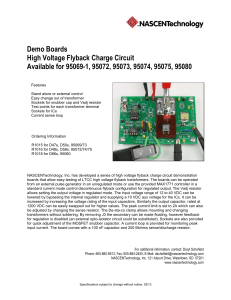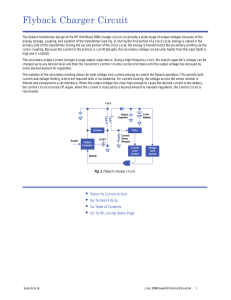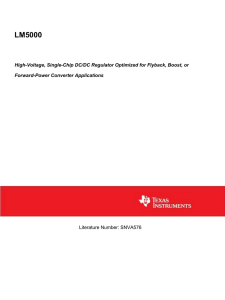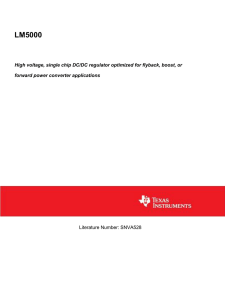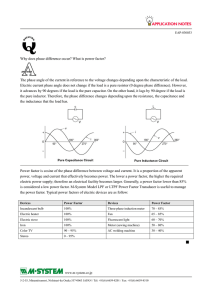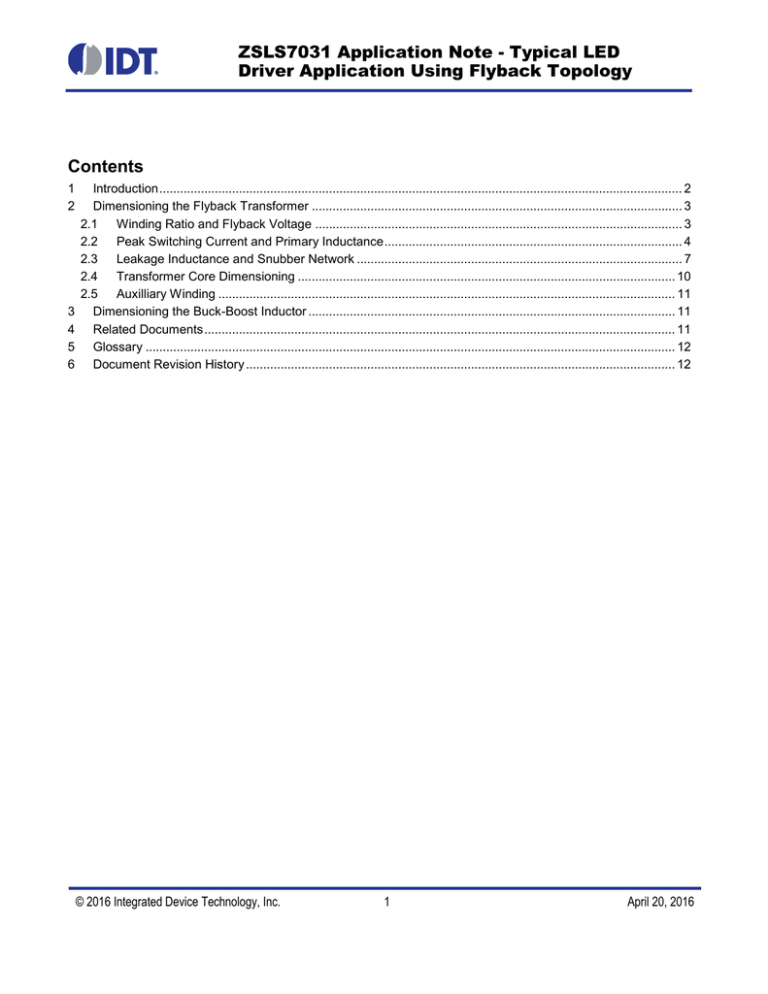
ZSLS7031 Application Note - Typical LED
Driver Application Using Flyback Topology
Contents
1
2
3
4
5
6
Introduction ....................................................................................................................................................... 2
Dimensioning the Flyback Transformer ........................................................................................................... 3
2.1 Winding Ratio and Flyback Voltage .......................................................................................................... 3
2.2 Peak Switching Current and Primary Inductance ...................................................................................... 4
2.3 Leakage Inductance and Snubber Network .............................................................................................. 7
2.4 Transformer Core Dimensioning ............................................................................................................. 10
2.5 Auxilliary Winding .................................................................................................................................... 11
Dimensioning the Buck-Boost Inductor .......................................................................................................... 11
Related Documents ........................................................................................................................................ 11
Glossary ......................................................................................................................................................... 12
Document Revision History ............................................................................................................................ 12
© 2016 Integrated Device Technology, Inc.
1
April 20, 2016
ZSLS7031 Application Note - Typical LED Driver Application Using Flyback Topology
1 Introduction
This application note demonstrates the design process for a flyback converter using IDT’s ZSLS7031 LED Driver
IC. A typical application circuit is shown in Figure 1.1.
The flyback converter should always operate in discontinuous mode (DCM) to achieve optimal supply voltage
compensation and the best power factor with minimized total harmonic distortions (THD). This leads to some
constraints regarding transformer dimensioning. In order to simplify the calculations, the transformer is initially
considered as “ideal”; i.e., it does not cause any losses (winding and core losses) and has no leakage inductance.
Figure 1.1 Typical LED Driver Application Circuit Using Flyback Topology
Snubber
VDC
+
aux.
ZSLS7031
VAC
VSINE
NC
© 2016 Integrated Device Technology, Inc.
2
VCC
GATE
FSET
CS
GND
FB
CY
April 20, 2016
ZSLS7031 Application Note - Typical LED Driver Application Using Flyback Topology
2 Dimensioning the Flyback Transformer
2.1
Winding Ratio and Flyback Voltage
The primary-over-secondary voltage ratio of the ideal transformer equals the winding ratio at any time as calculated in equation (1).
𝑉𝑝𝑝𝑝𝑝
𝑉𝑠𝑠𝑠
=
𝑛𝑝𝑝𝑝𝑝
(1)
𝑛𝑠𝑠𝑠
The path of the current flow of a flyback converter alternates between the primary and secondary, but on the
transition from primary to secondary current flow and vice versa, the current ratio is inversely proportional to the
winding ratio.
𝐼𝑠𝑠𝑠
𝐼𝑝𝑝𝑝𝑝
=
𝑛𝑝𝑝𝑝𝑝
(2)
𝑛𝑠𝑠𝑠
A low primary switching current is beneficial for achieving high efficiency; therefore a high winding ratio should be
targeted. However, a high winding ratio causes high flyback voltage and thus high drain voltage for the switching
transistor. It is good practice to dimension the maximum drain voltage to not exceed 75% of the transistor’s drain
voltage rating, including the “snubber voltage” overshoot, which will be discussed later.
A typical value for the flyback voltage Vfb (referenced to the momentary rectified line voltage VDC) in an off-line
design is in the order of 100V, which gives a reasonable margin for the voltage rating of a 500 to 600 V or 700 to
800 V MOSFET in a 120VAC or 230VAC application, respectively. Once the Vfb has been defined, the winding
ratio can be calculated from the LED forward voltage VLED and the secondary rectifier diode forward voltage VD
using equation (3).
𝑛𝑝𝑟𝑟𝑟
𝑛𝑠𝑠𝑠
=
𝑉𝑓𝑓
(3)
𝑉𝐿𝐿𝐿 +𝑉𝐷
After the transformer dimensioning is complete and an appropriate core has been selected, the number of turns n
can be calculated from the inductance L and the AL value given for the core using equation (4).
𝐿 = 𝐴𝐴 × 𝑛2 ⇒
© 2016 Integrated Device Technology, Inc.
𝐿
𝑛 = �𝐴𝐴
3
(4)
April 20, 2016
ZSLS7031 Application Note - Typical LED Driver Application Using Flyback Topology
2.2
Peak Switching Current and Primary Inductance
The best utilization of the transformer’s magnetic core is achieved when the converter operates just “on the edge”
of DCM under the worst-case conditions. Because the ZSLS7031 operates at a constant frequency and keeps the
maximum switching current in every half line-cycle constant, the worst-case condition occurs when both the
supply voltage and the load voltage (VLED) are at their minimum. The rising and falling edges of the current are
longest then and must fit into a single switching period tSW = 1/fSW.
In a power factor correction (PFC) design, i.e. when both line voltage and current have a sinusoidal shape, the
momentary power is a sin² function. Normalized to amplitudes of 1, the result is equation (5):
𝑠𝑠𝑛2 (ω𝑡) =
1
2
1
− 2 cos(2ω𝑡)
(5)
This is also a sinusoidal wave shape with twice the line frequency and a 50% offset. Its amplitude is 2 x the
average value. This leads to the conditions needed for the calculation of the transformer’s primary inductance.
Maximum power in the center of each half cycle is twice the average power, while voltage amplitude is
√2 x VACeff where VACeff is the effective AC supply voltage. Consequently the worst-case line current amplitude
can be determined with equation (6), where PAC is the average input power of the converter.
𝑃
𝐼𝑚𝑚𝑚 = √2 × 𝑉𝑉𝑉𝐴𝐴
𝑚𝑚𝑚
(6)
This current must be equal to the average primary current of the transformer in a single switching cycle. PAC is
higher than the LED power PLED since overall efficiency is always η < 100%.
𝑃𝐴𝐴 =
𝑃𝐿𝐿𝐿
η
(7)
A reasonable value to start calculations with is η = 0.85.
The next step is to define the switching frequency fSW . Higher frequencies lead to a smaller transformer but also to
higher switching losses (Pdyn ~ fSW) and thus lower efficiency. A fundamental upper limit of fSW is given by the
minimum on-time of the power transistor, defined by the blanking time tblank, which is typically 500ns. Typical
applications operate at fSW in the range of 50kHz to 100kHz.
Energy is stored in the magnetic core during the power transistor’s on-time and transferred into the output during
the off-time. Since the converter operates in DCM, there is no magnetic energy left at the end of each switching
cycle. This leads to the maximum pulse energy in the center of one half-cycle:
𝐸𝑝,𝑚𝑚𝑚 =
The energy stored in an inductor L equals
𝐸𝐿 =
© 2016 Integrated Device Technology, Inc.
1
2
2 𝑃𝐴𝐴
(8)
𝑓𝑠𝑠
𝐿 𝐼²
(9)
4
April 20, 2016
ZSLS7031 Application Note - Typical LED Driver Application Using Flyback Topology
Equations (8)and (9) must deliver the same result, therefore
2 𝑃𝐴𝐴
𝑓𝑠𝑠
=
1
2
𝐿 𝐼² ⇒ 𝐿 𝐼² =
4 𝑃𝐴𝐴
𝑓𝑠𝑠
(10)
During the on-time of the power transistor, the VAC amplitude voltage drops across the primary inductance, while
during off-time, the current decay is driven by the flyback voltage, which can be derived with equation (11).
𝑑𝑑
𝑑𝑑
© 2016 Integrated Device Technology, Inc.
=
𝑉
(11)
𝐿
5
April 20, 2016
ZSLS7031 Application Note - Typical LED Driver Application Using Flyback Topology
This results in
𝑡𝑜𝑜 =
𝐿𝑝𝑝𝑝𝑝 × 𝑖𝑠𝑠,𝑝𝑝𝑝𝑝
𝐿𝑝𝑝𝑝𝑝 × 𝑖𝑠𝑠,𝑝𝑝𝑝𝑝
𝑎𝑎𝑎 𝑡𝑜𝑜𝑜 =
√2 × 𝑉𝑉𝑉
𝑉𝑓𝑓
(12)
The ratio of ton/toff is given by the inverse voltage ratio during ton and toff.
𝑡𝑜𝑜
𝑡𝑜𝑜𝑜
𝑉𝑓𝑓
=
√2 × 𝑉𝑉𝑉
1
𝑤ℎ𝑒𝑒𝑒 𝑡𝑜𝑜 + 𝑡𝑜𝑜𝑜 ≤ 𝑡𝑠𝑠 = 𝑓
(13)
𝑠𝑠
In a typical application, ton is shorter than toff at the line voltage amplitude.
Under worst-case conditions, ton + toff = tSW is assumed. Simplifying √2 x VAC to the amplitude voltage Va gives
equation (14).
𝑉
𝑡𝑜𝑜𝑜 = 𝑡𝑜𝑜 × 𝑉𝑎
𝑓𝑓
𝑉
⇒ 𝑡𝑠𝑠 = 𝑡𝑜𝑜 × �1 + 𝑉𝑎 � ⇒ 𝑡𝑜𝑜 = 𝑡𝑠𝑠 × 𝑉
𝑉𝑓𝑓
𝑎 +𝑉𝑓𝑓
𝑓𝑓
(14)
During ton the current can be assumed to increase linearly. The average current is thus half the peak current
isw,peak. The average current iav over a full switching cycle tSW is then given by equation (15),
𝑖𝑎𝑎 =
1
𝑖
2 𝑠𝑠,𝑝𝑝𝑝𝑝
×𝑑
(15)
where the duty cycle d is given under worst-case conditions as
𝑑 =
𝑡𝑜𝑜
𝑡𝑠𝑠
=
𝑉𝑓𝑓,𝑚𝑚𝑚
(16)
𝑉𝑎,𝑚𝑚𝑚 + 𝑉𝑓𝑓,𝑚𝑚𝑚
Substituting equation (16) into (15) and taking into considering that iav must be equal to the line current amplitude
Imax yields equation (17).
𝑖𝑠𝑠,𝑝𝑝𝑝𝑝 = 2 ×
𝐼𝑚𝑚𝑚
𝑑
= 2 𝐼𝑚𝑚𝑚 ×
𝑉𝑎,𝑚𝑚𝑚 + 𝑉𝑓𝑓,𝑚𝑚𝑚
With Imax x Va,min = 2 PAC, equation (18) is derived.
𝑖𝑠𝑠,𝑝𝑝𝑝𝑝 = 4 𝑃𝐴𝐴 ×
(17)
𝑉𝑓𝑓,𝑚𝑚𝑚
𝑉𝑎,𝑚𝑚𝑚 + 𝑉𝑓𝑓,𝑚𝑚𝑚
(18)
𝑉𝑎,𝑚𝑚𝑚 × 𝑉𝑓𝑓,𝑚𝑚𝑚
During ton the pulse energy given in equation (8) must be stored in the magnetic core. This leads to the
transformer’s primary inductance Lprim being
𝐿𝑝𝑝𝑝𝑝 = 𝑡𝑜𝑜 ×
𝑉𝑎,𝑚𝑚𝑚
𝑖𝑠𝑠,𝑝𝑝𝑝𝑝
© 2016 Integrated Device Technology, Inc.
= 𝑡𝑠𝑠 ×
𝑉𝑓𝑓,𝑚𝑚𝑚
𝑉𝑎,𝑚𝑚𝑚 + 𝑉𝑓𝑓,𝑚𝑚𝑚
6
×
𝑉𝑎,𝑚𝑚𝑚
𝑖𝑠𝑠,𝑝𝑝𝑝𝑝
⇒
(19)
April 20, 2016
ZSLS7031 Application Note - Typical LED Driver Application Using Flyback Topology
𝐿𝑝𝑝𝑝𝑝 = 𝑖
Substituting (18) into (19) yields
𝑡𝑠𝑠
𝑠𝑠,𝑝𝑝𝑝𝑝
𝑡
×
𝑉
𝑉𝑎,𝑚𝑚𝑚 × 𝑉𝑓𝑓,𝑚𝑚𝑚
𝑉𝑎,𝑚𝑚𝑚 + 𝑉𝑓𝑓,𝑚𝑚𝑚
𝐿𝑝𝑝𝑝𝑝 = 4 𝑃𝑠𝑠 × � 𝑉𝑎,𝑚𝑚𝑚
2.3
𝐴𝐴
𝑎,𝑚𝑚𝑚
× 𝑉𝑓𝑓,𝑚𝑚𝑚
+ 𝑉𝑓𝑓,𝑚𝑚𝑚
2
�
(20)
Leakage Inductance and Snubber Network
A real transformer shows primary and secondary leakage inductance, which is not “linked” to the respective other
side, i.e. current driven into the primary leakage inductance cannot continue flowing in the secondary and vice
versa. In the electrical-equivalent diagram of a transformer, the leakage inductances Lleak,prim and Lleak,sec are
connected in series with the main winding inductance on each side as shown in Figure 2.1.
Figure 2.1 Electrical-Equivalent Transformer with Primary and Secondary Leakage Inductances
snubber
R snub
+
C snub
D snub
L leak,prim
L leak,sec
Consequently, when the peak switching current is reached and the transistor is turned off, Lleak,prim causes the
primary current to continue flowing, while Lleak,sec prevents the secondary current from abruptly starting to flow.
The primary current charges the parasitic node capacitance on the transistor’s drain up to its breakdown voltage.
To avoid this repetitive stress condition, a snubber network consisting of a capacitor, a resistor, and a diode is
added, limiting the voltage to a level below the drain breakdown (see Figure 1.1 and Figure 2.1). The capacitor is
typically several nF and large enough to absorb the single pulse energy without significant voltage increase. The
resistor discharges the capacitor continuously and must dissipate the average power that is fed into the snubber
capacitor. The snubber voltage must be higher than the flyback voltage Vfb, because Vfb is still present after the
energy from the leakage inductance has been transferred.
The higher the snubber voltage Vsnub is, the faster the current in the leakage inductor decays, thus reducing the
average current into the snubber capacitor. Since Vfb is always superimposed, a higher Vsnub reduces the power
dissipation of the snubber resistor. However, it also increases the Pdiss of the power transistor because drain
current continues flowing up to the higher Vsnub. In this situation, transient transistor losses are inversely proportional to the switching speed.
© 2016 Integrated Device Technology, Inc.
7
April 20, 2016
ZSLS7031 Application Note - Typical LED Driver Application Using Flyback Topology
Numerical calculation of the snubber resistor and its losses is complex. A simplified approach will be used here to
establish a good starting point for the optimization. It disregards the fact that on the rising edge of the power
transistor’s drain voltage (i.e., switching the transistor off), there is already energy transferred from the leakage
inductance into the parasitic node capacitance and the transistor, conducting in linear mode.
The peak switching current flow is the same in the primary inductance and primary leakage inductance. Current
commutation from primary to secondary is limited by the decay of current in the primary and by the increase in the
secondary leakage inductance. At the end of the transistor’s drain voltage rising edge, the difference between
Vsnub and Vfb drops across the primary and transformed secondary leakage inductances, virtually connected in
series. Advantageously, this sum is exactly what is being measured when shorting the secondary and measuring
the remaining inductance on the primary side. The resulting Lleak can be calculated with equation (21):
𝑛𝑝𝑝𝑝𝑝 2
𝐿𝑙𝑙𝑙𝑙 = 𝐿𝑙𝑙𝑙𝑙,𝑝𝑝𝑝𝑝 + �
𝑛𝑠𝑠𝑠
� × 𝐿𝑙𝑙𝑙𝑙,𝑠𝑠𝑠
(21)
The primary current decay is thus given by equation (22).
𝑑𝑑𝑙𝑙𝑙𝑙
𝑑𝑑
=
𝑉𝑠𝑠𝑠𝑠 − 𝑉𝑓𝑓
(22)
𝐿𝑙𝑙𝑙𝑙
Assuming current decay to be linear over the decay time tdecay, this leads to the average current driven into the
snubber network:
1
𝐼𝑠𝑠,𝑎𝑎 = 2 𝐼𝑝𝑝𝑝𝑝 ×
1
𝑡𝑑𝑑𝑑𝑑𝑑
𝑡𝑠𝑠
1
= 2 𝐼𝑝𝑝𝑝𝑝 ×
𝐼𝑠𝑠,𝑎𝑎 = 2 𝐼²𝑝𝑝𝑝𝑝 ×
𝐿𝑙𝑙𝑙𝑙
𝑉𝑠𝑠𝑠𝑠 − 𝑉𝑓𝑓
𝐼𝑝𝑝𝑝𝑝
𝑑𝑑𝑙𝑙𝑙𝑙
𝑑𝑑
× 𝑓𝑠𝑠
× 𝑓𝑠𝑠
(23)
Power dissipation of the snubber resistor can therefore be calculated as
1
𝑃𝑑𝑑𝑑𝑑,𝑠𝑠 = 𝐼𝑠𝑠,𝑎𝑎 × 𝑉𝑠𝑠𝑠𝑠 = � 2 𝐼 2 𝑝𝑝𝑝𝑝 × 𝐿𝑙𝑙𝑙𝑙 × 𝑓𝑠𝑠 � ×
𝑉𝑠𝑠𝑠𝑠
𝑉𝑠𝑠𝑠𝑠 − 𝑉𝑓𝑓
(24)
where the term in brackets is the average power stored in the leakage inductance. It is obvious that the snubber
network must dissipate this power as a minimum.
The snubber resistor can be calculated from equation (24) by considering the conditions at the AC voltage peak
where Vsnub is highest and the momentary power is twice the average (2 x PAC). The power stored in the leakage
inductance becomes
𝐿
𝑃𝑙𝑙𝑙𝑙,𝑚𝑚𝑚 = 2 𝑃𝐴𝐴 × 𝐿 𝑙𝑙𝑙𝑙
𝑝𝑝𝑝𝑝
© 2016 Integrated Device Technology, Inc.
8
(25)
April 20, 2016
ZSLS7031 Application Note - Typical LED Driver Application Using Flyback Topology
and therefore
𝐿
𝑃𝑑𝑑𝑑𝑑,𝑚𝑚𝑚 = 2 𝑃𝐴𝐴 × 𝐿𝑙𝑙𝑙𝑙 ×
𝑝𝑝𝑝𝑝
𝑉𝑠𝑠𝑠𝑠
(26)
𝑉𝑠𝑠𝑠𝑠 − 𝑉𝑓𝑓
giving the value of the resistor Rsnub in the snubber network:
𝑅𝑠𝑠𝑠𝑠 =
𝑉²𝑠𝑠𝑠𝑠
𝑃𝑠𝑠𝑠𝑠
=
𝑉²𝑠𝑠𝑠𝑠
𝐿𝑙𝑙𝑙𝑙
𝑉𝑠𝑠𝑠𝑠
2 𝑃𝐴𝐴 ×
×
𝐿𝑝𝑝𝑝𝑝
𝑉𝑠𝑠𝑠𝑠 − 𝑉𝑓𝑓
=
𝑉𝑠𝑠𝑠𝑠 × (𝑉𝑠𝑠𝑠𝑠 − 𝑉𝑓𝑓 )
𝐿
2 𝑃𝐴𝐴 × 𝑙𝑙𝑙𝑙
𝐿𝑝𝑝𝑝𝑝
(27)
Vsnub should be as high as possible for low snubber losses, but a high Vsnub also requires a high voltage rating and
causes higher losses in the power transistor. A reasonable compromise is to assume that Vsnub is (2 to 2.5) x Vfb
in the center of the sine wave (e.g., Vsnub = 200 to 250 V above VDC when Vfb = 100 V). This leads to the peak
power dissipation of the snubber resistor being 2 to 1.65 times the power stored in Lleak.
The average power dissipation of the snubber resistor can be estimated by assuming the power wave shape to
be a sinusoidal curve with its maximum as defined above and the minimum given by the flyback voltage dropping
across Rsnub when the line voltage crosses zero. This leads to equation (28).
1
1
𝑃𝑑𝑑𝑑𝑑,𝑎𝑎 (𝑅𝑠𝑠𝑠𝑠 ) = 𝑃𝑚𝑚𝑚 + 2 (𝑃𝑚𝑚𝑚 − 𝑃𝑚𝑚𝑚 ) = 2 (𝑃𝑚𝑚𝑚 + 𝑃𝑚𝑚𝑚 )
𝑉𝑓𝑓
1
𝑃𝑑𝑑𝑑𝑑,𝑎𝑎 (𝑅𝑠𝑠𝑠𝑠 ) = 2 𝑃𝑑𝑑𝑑𝑑,𝑚𝑚𝑚 �1 + �𝑉
𝑠𝑠𝑢𝑏
2
� �
(28)
As mentioned previously, this derivation neglects the energy reduction in the leakage inductance during the rising
edge of the power transistor’s drain voltage. This amount is not negligible, and in a typical application can be
considered to be in the order of 30%. The snubber resistor should therefore be chosen to be 40% higher than
calculated, while its power dissipation can be considered 30% lower. Final optimization must be done on the
actual application circuit.
Low leakage inductance of the transformer is essential for good efficiency of the flyback converter. In order to
keep Lleak and the related power dissipation low, it is advantageous to interleave primary and secondary windings.
This might not be simple if a high isolation voltage (e.g., 4kV) is required. A common approach is to split the
primary into two layers with half the total number of turns each and place the secondary between the two layers,
with a sufficient isolation layer on its top and bottom. A slightly better result can be achieved when splitting the
secondary and placing the primary between the two layers. In many cases, the secondary voltage is lower than
the primary, while the current is higher. If so, it makes sense to split the secondary into two layers with the full
number of turns each and connect them in parallel externally.
Splitting the secondary has an additional advantage: an auxiliary winding on the transformer is often used to
supply the controller IC during operation and also provide information about the output voltage; e.g., for
overvoltage shutdown. The auxiliary winding gives a much better image of the output voltage when it is not placed
in close proximity with the primary, but rather with the secondary as a type of shield between the auxiliary and
primary windings. Typically the load current of the auxiliary winding is low (a few mA), and the “shield” avoids
peak rectifying the snubber ringing coupled from the primary.
© 2016 Integrated Device Technology, Inc.
9
April 20, 2016
ZSLS7031 Application Note - Typical LED Driver Application Using Flyback Topology
2.4
Transformer Core Dimensioning
Primarily for cost reasons, the transformer is often realized using an E-E type ferrite core with a center air gap.
The pulse energy is primarily stored in the air gap since for a given flux density, the specific energy (energy per
volume) of a magnetic field is inversely proportional to the magnetic permeability µ.
𝐵2
ρ𝑚 = 2 µ
(29)
Typical ferrite materials saturate at flux densities between 300mT and 350mT, so a reasonable maximum
operational flux should not exceed 250mT (2500G). The air gap’s permeability is nearly the same as the vacuum
permeability µ0 (µr ≈ 1).
𝑉𝑠
µ0 = 4 π × 10−7 �𝐴 𝑚�
(30)
With the pulse energy Ep, the required air gap volume Vag is given by equation (31).
𝑉𝑎𝑎 =
2 𝐸𝑝 µ0
𝐵2
[𝑚3 ]
(31)
For simplification, equation (32) can be used, providing a result in mm³ rather than m³:
𝑉𝑎𝑎 =
2513 𝐸𝑝
𝐵²
[𝑚𝑚³]
(32)
The further assumption of Bmax = 250mT (= 0.25T) results in equation (33)
𝑉𝑎𝑎 = 40208 𝐸𝑝 [𝑚𝑚³]
(33)
Alternatively, equation (34) can be used as a rule of thumb.
𝑉𝑎𝑎 ≈ 40
© 2016 Integrated Device Technology, Inc.
𝑚𝑚3
(34)
𝑚𝑚𝑚
10
April 20, 2016
ZSLS7031 Application Note - Typical LED Driver Application Using Flyback Topology
2.5
Auxilliary Winding
The transformer contains an auxiliary winding that is used to supply the ZSLS7031 during operation and also
provide a voltage feedback for output open-load (overvoltage) protection. The number of turns for this voltage
should be chosen to achieve an output voltage VCC = 12 to 14 V at nominal LED voltage using equation (35).
𝑛𝑎𝑎𝑎
𝑛𝑠𝑠𝑠
=
𝑉𝐶𝐶
(35)
𝑉𝐿𝐿𝐿
3 Dimensioning the Buck-Boost Inductor
The buck-boost converter can be considered as a special case of the flyback converter where the transformer’s
primary/secondary ratio equals 1 and the secondary is simply left out, which of course sacrifices isolation. This
topology is advantageous in terms of efficiency when the LED voltage is reasonably high; i.e., in the region where
the flyback voltage would be with a transformer present. Since a single inductor does not have leakage inductance, a snubber dissipating the related energy is not needed.
Considering this, all equations for calculating the transformer’s primary inductance in a flyback converter are valid
for a buck-boost inductor also by simply assuming the following.
𝑛𝑝𝑝𝑝𝑝 = 𝑛𝑠𝑠𝑠 , 𝐼𝑝𝑝𝑝𝑝 = 𝐼𝑠𝑠𝑠 , 𝑉𝑓𝑓 = 𝑉𝐿𝐿𝐿 + 𝑉𝐷
(36)
The operating supply current for the ZSLS7031 in a buck-boost converter can be provided from an auxiliary
winding on the inductor, making it a transformer again (but without the need for a snubber), or by an alternative
supply concept described in the ZSLS7031 Application Note—230VAC Buck-Boost Converter for 45 LEDs.
4 Related Documents
Document
ZSLS7031 Data Sheet
ZSLS7031 Application Note—230VAC Buck-Boost Converter
for 45 LEDs.
Visit the ZSLS7031 product page at www.IDT.com/ZSLS7031 or contact your nearest sales office for the latest
version of these documents.
© 2016 Integrated Device Technology, Inc.
11
April 20, 2016
ZSLS7031 Application Note - Typical LED Driver Application Using Flyback Topology
5 Glossary
Term
Description
DCM
Discontinuous Mode
FB
Feedback
PFC
Power Factor Correction
THD
Total Harmonic Distortion
6 Document Revision History
Revision
Date
Description
1.00
April 28, 2014
First release.
April 20, 2016
Changed to IDT branding.
Corporate Headquarters
Sales
6024 Silver Creek Valley Road
San Jose, CA 95138
www.IDT.com
1-800-345-7015 or 408-284-8200
Fax: 408-284-2775
www.IDT.com/go/sales
Tech Support
www.IDT.com/go/support
DISCLAIMER Integrated Device Technology, Inc. (IDT) reserves the right to modify the products and/or specifications described herein at any time, without notice, at IDT's sole discretion. Performance
specifications and operating parameters of the described products are determined in an independent state and are not guaranteed to perform the same way when installed in customer products. The
information contained herein is provided without representation or warranty of any kind, whether express or implied, including, but not limited to, the suitability of IDT's products for any particular purpose, an
implied warranty of merchantability, or non-infringement of the intellectual property rights of others. This document is presented only as a guide and does not convey any license under intellectual property
rights of IDT or any third parties.
IDT's products are not intended for use in applications involving extreme environmental conditions or in life support systems or similar devices where the failure or malfunction of an IDT product can be
reasonably expected to significantly affect the health or safety of users. Anyone using an IDT product in such a manner does so at their own risk, absent an express, written agreement by IDT.
Integrated Device Technology, IDT and the IDT logo are trademarks or registered trademarks of IDT and its subsidiaries in the United States and other countries. Other trademarks used herein are the
property of IDT or their respective third party owners. For datasheet type definitions and a glossary of common terms, visit www.idt.com/go/glossary. All contents of this document are copyright of Integrated
Device Technology, Inc. All rights reserved.
© 2016 Integrated Device Technology, Inc.
12
April 20, 2016

